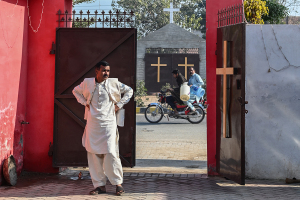European Court Upholds Crucifixes in Public Schools
The European Court of Human Rights ruled Friday that public schools in Italy can continue to display crucifixes in the classrooms.
Voting 15 to 2, the court's Grand Chamber decided that while the crucifix is a religious symbol, the presence of the crucifix did not breach the rights of non-Catholics or atheists.
"There is no evidence before the Court that the display of a religious symbol on classroom walls may have an influence on pupils," the ruling stated.
Vatican spokesman Federico Lombardi hailed the decision as an "important and historic ruling," according to a statement.
The decision is binding in 47 countries that are members of the Council of Europe.
The case was initially brought by Soile Lautsi, a Finnish-born mother of two children attending a state school near Venice. She filed suit in Italian courts after the school officials refused her request to remove crucifixes from the classrooms.
Lautsi alleged that the crucifix violated the principle of secularism. She took her case to European courts after being repeatedly rejected by Italian courts.
Friday's ruling reversed a 2009 decision made by a lower chamber of the ECHR that found crucifixes could be "emotionally disturbing" to non-Catholic pupils.
Italy appealed the decision, joined by several European countries including the Russian Federation, Greece and Romania.
"The popular sentiment in Europe has won today," said Italian Foreign Minister Franco Frattini, according to Italy's La Repubblica newspaper.
"The decision underlines, above all, the rights of citizens to defend their own values and their own identities," said Frattini.
"I hope that following this verdict Europe will begin to examine issues of tolerance and religious freedom with the same courage."
In today's decision, the Grand Chamber also ruled that the question whether crucifixes should be present in classrooms was, in principle, a matter falling within the margin of appreciation of the State. In this particular case, the court upheld the margin of appreciation in Italy's case, concluding that the practice of displaying crucifixes did not amount to "indoctrination."
"The European Court of Human Rights shouldn't overstep its authority and force a member nation to abandon traditions and beliefs that it has a sovereign right to protect if it so chooses," said Roger Kiska, legal counsel of Alliance Defense Fund, who was present at the announcement of the court's decision.
Last year, ADF attorneys were granted permission by the European court to intervene in the suit on behalf of 33 members of the European Parliament.
"A loss in this case would have meant, in essence, that it would be illegal under the European Convention on Human Rights to have religious symbols in any state institution anywhere in Europe," commented Kiska.
"That would have set a dangerous example for the rest of the world."
The ECHR reached a decision in case of Lautsi and Others v. Italy on Feb. 16 but the ruling was announced Friday.





























